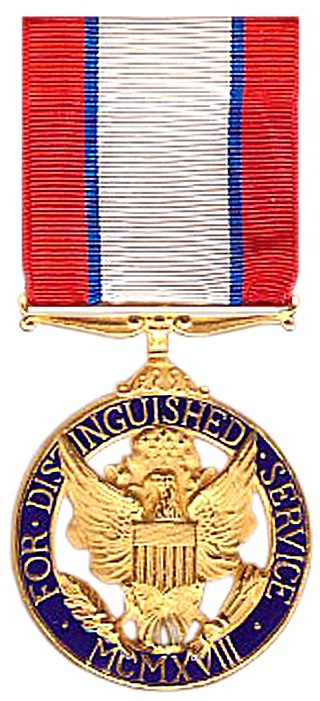
The Distinguished Service Medal (DSM) is a military decoration of the United States Army that is presented to soldiers who have distinguished themselves by exceptionally meritorious service to the government in a duty of great responsibility. The performance must be such as to merit recognition for service that is clearly exceptional. The exceptional performance of normal duty will not alone justify an award of this decoration.

Lieutenant General Stanisław Maczek was a Polish tank commander of World War II, whose division was instrumental in the Allied liberation of France, closing the Falaise pocket, resulting in the destruction of 14 German Wehrmacht and SS divisions. A veteran of World War I, the Polish–Ukrainian and Polish–Soviet Wars, Maczek was the commander of Poland's only major armoured formation during the September 1939 campaign, and later commanded a Polish armoured formation in France in 1940. He was the commander of the famous 1st Polish Armoured Division, and later of the I Polish Army Corps under Allied Command in 1942–45.

The Distinguished Flying Cross (DFC) is a military decoration of the United States Armed Forces. The medal was established on July 2, 1926, and is currently awarded to any persons who, after April 6, 1917, distinguish themselves by single acts of heroism or extraordinary achievement while participating in aerial flight. Both heroism and extraordinary achievement are entirely distinctive, involving operations that are not routine. The medal may be awarded to friendly foreign military members in ranks equivalent to U.S. Pay Grade of O-6 and below, in combat in support operations.
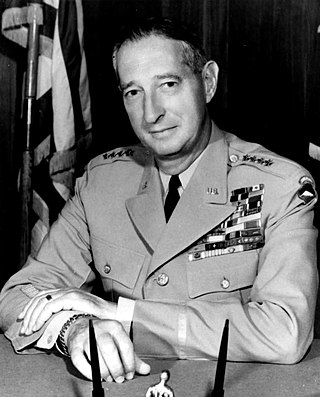
Mark Wayne Clark was a United States Army officer who saw service during World War I, World War II, and the Korean War. He was the youngest four-star general in the US Army during World War II.

General James Alward Van Fleet was a United States Army officer who saw service during World War I, World War II and the Korean War. Van Fleet was a native of New Jersey, who was raised in Florida and graduated from the United States Military Academy. He served as a regimental, divisional and corps commander during World War II and as the commanding general of United States Army and other United Nations forces during the Korean War.

Johannes Albrecht Blaskowitz was a German Generaloberst during World War II. He was a recipient of the Knight's Cross of the Iron Cross with Oak Leaves and Swords. After joining the Imperial German Army in 1901, Blaskowitz served throughout World War I, where he earned an Iron Cross for bravery.
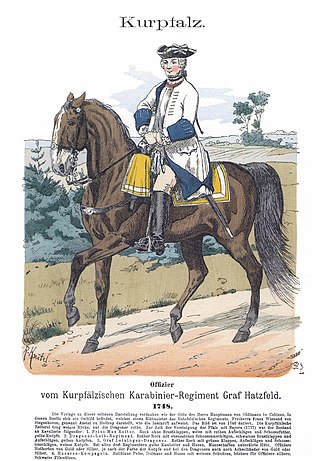
Rittmaster is or was a military rank of a commissioned cavalry officer in the armies of Germany, Austria-Hungary, Norway, Sweden, Denmark, and some other countries. A Rittmeister is typically in charge of a squadron, and is the equivalent of a Hauptmann rank.

Nottuln is a municipality in the district of Coesfeld in the state of North Rhine-Westphalia, Germany.

Rengsdorf is a municipality in the district of Neuwied, in Rhineland-Palatinate, Germany. It is situated in the Westerwald, approx. 10 km north of Neuwied.

General Sir Kenneth Arthur Noel Anderson, was a senior British Army officer who saw service in both world wars. He is mainly remembered as the commander of the British First Army during Operation Torch, the Allied invasion of North Africa and the subsequent Tunisian campaign which ended with the capture of almost 250,000 Axis soldiers. An outwardly reserved character, he did not court popularity either with his superiors or with the public.
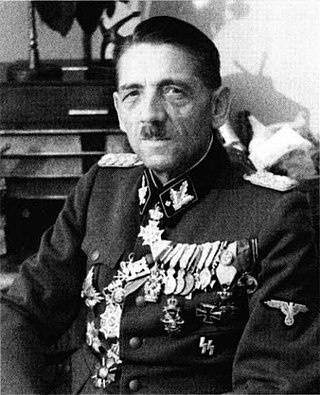
Artur Gustav Martin Phleps was an Austro-Hungarian, Romanian and German army officer who held the rank of SS-Obergruppenführer und General der Waffen-SS in the Waffen-SS during World War II. At the post-war Nuremberg trials, the Waffen-SS – of which Phleps was a senior officer – was declared to be a criminal organisation due to its major involvement in war crimes and crimes against humanity. An Austro-Hungarian Army officer before and during World War I, Phleps specialised in mountain warfare and logistics, and had been promoted to Oberstleutnant by the end of the war. During the interwar period he joined the Romanian Army, reaching the rank of General-locotenent, and also became an adviser to King Carol. After he spoke out against the government he was sidelined and asked to be dismissed from the army.

Lê Văn Hưng was an infantry general of the Army of the Republic of Vietnam.

The Allied leaders of World War II listed below comprise the important political and military figures who fought for or supported the Allies during World War II. Engaged in total war, they had to adapt to new types of modern warfare, on the military, psychological and economic fronts.
The 2nd Shock Army, sometimes translated to English as 2nd Assault Army, was a field army of the Soviet Union during the Second World War. This type of formation was created in accordance with prewar doctrine that called for Shock Armies to overcome difficult defensive dispositions in order to create a tactical penetration of sufficient breadth and depth to permit the commitment of mobile formations for deeper exploitation. However, as the war went on, Shock Armies lost this specific role and reverted, in general, to ordinary frontline formations.
Lieutenant General A.G.D. (Ton) van Osch is a senior Dutch military commander and past Director General of the European Union Military Staff.
The Federal Ministry of Defence of Austria is the ministry in charge of all matters relating to military affairs, especially the Austrian Armed Forces. It is Austria's ministry of defence. Its current minister is Klaudia Tanner.

Lieutenant General Sir John Gordon Lorimer, is a retired senior British Army officer, who served as the Chief of Joint Operations and the Defence Senior Adviser to the Middle East and North Africa. He was appointed Lieutenant Governor of the Isle of Man on 29 September 2021.
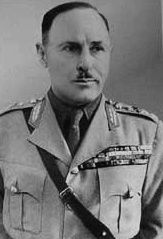
Konstantinos Ventiris was a Hellenic Army officer who rose to the rank of lieutenant general. He served twice as Chief of the Hellenic Army General Staff and was one of the senior government commanders during the Greek Civil War. He is also one of the few recipients the country's highest wartime decoration, the Commander's Cross of the Cross of Valour.















